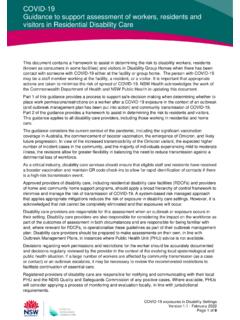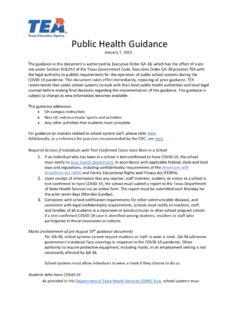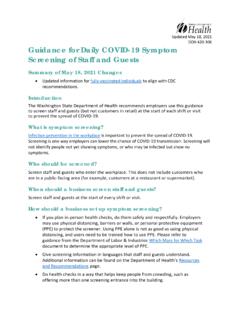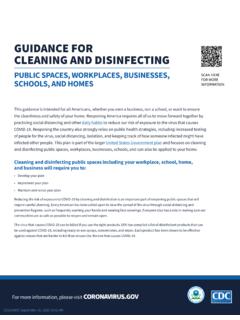Transcription of COVID-19 Long-Term Care Facility Guidance
1 COVID-19 Long-Term care Facility Guidance April 2, 2020 The Centers for Medicare & Medicaid Services (CMS) and the Centers for Disease Control and Prevention (CDC) are issuing new recommendations to State and local governments and Long-Term care facilities (also known as nursing homes) to help mitigate the spread of the 2019 Novel Coronavirus ( COVID-19 ). Long-Term care facilities are a critical component of America s healthcare system. They are unique, as they serve as both healthcare providers and as full-time homes for some of the most vulnerable Americans. In recent weeks, CMS and CDC, at President Trump s direction, have worked together to swiftly issue unprecedented targeted direction to the Long-Term care Facility industry, including a general prohibition of visitors implemented on March 13, 2020, as well as strict infection control and other screening recommendations.
2 However, recent observations made by CDC and CMS experts onsite in facilities have emphasized that even more must be done to universally implement this key Guidance . To provide critical, needed leadership for the Nation s Long-Term care facilities to prevent further spread of COVID-19 , CMS and CDC are now recommending the following immediate actions to keep patients and residents safe: 1. Nursing Homes should immediately ensure that they are complying with all CMS and CDC Guidance related to infection control. In particular, facilities should focus on adherence to appropriate hand hygiene as set forth by CDC. CMS has also recently issued extensive infection control Guidance , including a self-assessment checklist that Long-Term care facilities c an use to determine their compliance with these crucial infection control actions.
3 Facilities should also refer to CDC s Guidance to Long-Term care facilities on COVID-19 and also use Guidance on conservation of personal protective equipment (PPE) when unable to follow the Long-Term care Facility Guidance . 2. As Long-Term care facilities are a critical part of the healthcare system, and because of the ease of spread in Long-Term care facilities and the severity of illness that occurs in residents with COVID-19 , CMS urges State and local leaders to consider the needs of Long-Term care facilities with respect to supplies of PPE and COVID-19 tests. State and local health departments should work together with Long-Term care facilities in their communities to determine and help address Long-Term care Facility needs for PPE and/or COVID-19 tests.
4 Medicare is now covering COVID-19 testing when furnished to eligible beneficiaries by certified laboratories. These laboratories may also choose to enter facilities to conduct COVID-19 testing. 3. Long-Term care facilities should immediately implement symptom screening for all. In accordance with previous CMS Guidance , every individual regardless of reason entering a Long-Term care Facility ( including residents, staff, visitors , outside healthcare workers, vendors, etc.) should be asked about COVID-19 symptoms and they must also have their temperature checked. An exception to this is Emergency Medical Service (EMS) workers responding to an urgent medical need. They do not have to be screened, as they are typically screened separately.
5 Facilities should limit access points and ensure that all accessible entrances have a screening station. In accordance with previous CDC Guidance , every resident should be assessed for symptoms and have their temperature checked every day. Patients and residents who enter facilities should be screened for COVID-19 through testing, if available. 4. Long-Term care facilities should ensure all staff are using appropriate PPE when they are interacting with patients and residents, to the extent PPE is available and per CDC Guidance on conservation of PPE. For the duration of the state of emergency in their State, all Long-Term care Facility personnel should wear a facemask while they are in the Facility . Full PPE should be worn per CDC guidelines for the care of any resident with known or suspected COVID-19 per CDC Guidance on conservation of PPE.
6 If COVID-19 transmission occurs in the Facility , healthcare personnel should wear full PPE for the care of all residents irrespective of COVID-19 diagnosis or symptoms. Patients and residents who must regularly leave the Facility for care ( , hemodialysis patients) should wear facemasks when outside of their rooms. When possible, all Long-Term care Facility residents, whether they have COVID-19 symptoms or not, should cover their noses and mouths when staff are in their room. Residents can use tissues for this. They could also use cloth, non-medical masks when those are available. Residents should not use medical facemasks unless they are COVID-19 -positive or assumed to be COVID-19 -positive. 5. To avoid transmission within Long-Term care facilities, facilities should use separate staffing teams for COVID-19 -positive residents to the best of their ability, and work with State and local leaders to designate separate facilities or units within a Facility to separate COVID-19 negative residents from COVID-19 positive residents and individuals with unknown COVID-19 status.
7 Long-Term care facilities should exercise as best as possible consistent assignment (meaning the assignment of staff to certain patients and residents) for all patients and residents regardless of symptoms or COVID-19 status. This practice can enhance staff s familiarity with their assigned patients and residents, helping them detect emerging condition changes that unfamiliar staff may not notice. The goal is to decrease the number of different staff interacting with each patient and resident as well as the number of times those staff interact with the patient and resident. Also, staff as much as possible should not work across units or floors. i. Long-Term care facilities should redeploy existing training related to consistent assignment, and ensure staff are familiar with the signs and symptoms of COVID-19 .
8 Long-Term care facilities should separate patients and residents who have COVID-19 from patients and residents who do not, or have an unknown status. i. To this end, Long-Term care facilities should work with State and local community leaders to identify and designate facilities dedicated to patients and residents with known COVID-19 -positive and those with suspected COVID-19 , ensuring they are separate from patients and residents who are COVID-19 -negative; ii. COVID-19 -positive units and facilities must be capable of maintaining strict infection control practices and testing protocols, as required by regulation; 1. When possible, facilities should exercise consistent assignment, or have separate staffing teams for COVID-19 -positive and COVID-19 -negative patients.
9 Iii. There may be a need for some of these COVID-19 -positive Long-Term care facilities to have the capacity, staffing, and infrastructure to manage higher intensity patients, including ventilator management; iv. State agencies including health departments, hospitals, and nursing home associations will have to ensure coordination among facilities to determine which facilities will have a designation and to provide adequate staff supplies and PPE; and, if possible, isolate all admitted residents ( including readmissions) in their room in the COVID-19 -positive Facility for 14 days if their COVID-19 status is unknown; and v. Long-Term care facilities should, to the fullest extent possible, inform residents and their families of limitations of their access to and ability to leave and re-enter the Facility , as well as any requirements and procedures for placement in alternative facilities for COVID-19 -positive or unknown status.
10 ###














